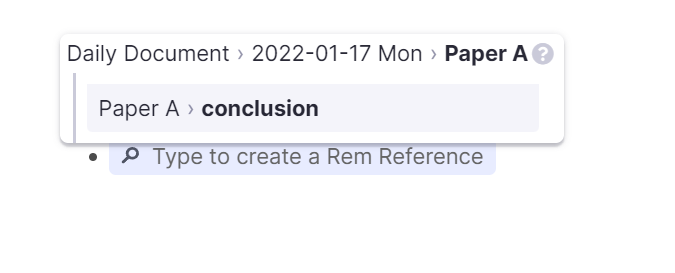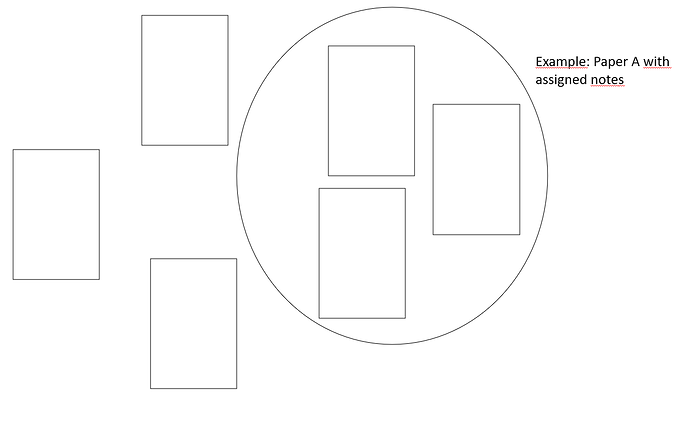I, too, have many notes that contain terms like ‘conclusion’, ‘additional resources’ or ‘comments’, etc… Hm. But let me propose an idea - wouldn’t it be nice to assign individual documents and Rem to individual projects?
I think stuff, as described by @_yb, happens on its own when you follow a certain workflow and want to structure your notes in a certain way. And thank you for the suggested solution, @subbus. It works - even if I have the feeling that it is more of a workaround than a solution to the actual problem. Because:
As I see it, the problem exists on two levels. The first level is that recurring Rem like ‘conclusion’ used to structure the notes are only relevant to the document in question - for example, all conclusions for Paper A.
The second level concerns the entire knowledge base, on a global level, so to speak.
I often create a project-related folder for individual writing projects (articles, book chapters, blog posts) - a project-related folder for Paper A, for example. This folder then contains certain documents - one for the manuscript itself, one for the individual topics (which often grows into the outline of a paper), one for the sources, one for the conclusions, etc. These documents and Rem are now, of course, also part of the entire knowledge base, at the same time. However, they have - just like ‘conclusion’ in the previous example - recurring and non-unique names and are only relevant for the respective writing project.
(So I always start with the projects - you could say I am using a slightly modified version of the PARA method. It proved very effective.) (See, for instance, here: https://fortelabs.co/blog/para/)
However, what adds to the second situation described above is that I now collect all the conclusions directly relevant to that writing project - and these Rem, in turn, are also part of the entire knowledge base.
On the one hand, this is wonderful, and as @_yb also writes, I love that all Rem - just everything - can be referenced to each other. It is one of the reasons why I switched to RemNote.
On the other hand, the more extensive the knowledge base and the more completed writing projects I have, the more references and Rem clutter it - many of them carrying more or less the same name. This creates increasing chaos in my search mask, and I increasingly lose the overview. This ‘cluttering’ of the Knowledge Base also means that above a certain size of the database, the advantages of RemNote’s remarkable Rem architecture are (a) cancelled out, and (b) you lose speed; (c) the program needs to calculate more and may become unresponsive.
Hence my idea:
Both on the document level and on the ‘global’ level, it should be possible to mark those Rem that are only relevant for the parent element - conclusions for paper A on document level, all documents and their content added for project A (or B, C, …). It should be possible to assign individual elements (Rem, documents, etc.) to individual projects. Such assignment could be achieved quite easily, I think, similar to how Rem can now be turned into documents and back.
Descriptors do this in a somewhat limited way; it’s true. But with the idea described above, one then hasn’t to manually prevent the creation of flashcards. Moreover, it would be theoretically possible to switch seamlessly between a view of the entire knowledge base and a view of only those documents and Rem that are relevant to the current project. In my eyes, this is a decisive advantage over descriptors - again, the more the size of the knowledge base increases. You will have complete focus on what you are currently doing. When you are done with your work on a particular project, you could switch the view - et voilà - you are back in the entire knowledge base.
Some excellent software used by my colleagues at university - Citavi - works with projects. Besides better focus, this has immense advantages in planning and executing projects. However, there always remains a gap between the entire knowledge base and the individual project - newly created entries must be laboriously transferred back to the global knowledge base and vice versa. I think RemNote would be in an excellent position to handle this better.
For inspiration and further understanding: Kevin Lin, the founder of Dendron, illustrates the problem (and his solution) very well in this interview (see where they talk about schemata): Redefining knowledge management with Kevin Lin, founder of Dendron
I know that there may be other solutions to this problem; but for me, this would really be a gamechanger and actually increase my productivity.
 .
.





 !
!